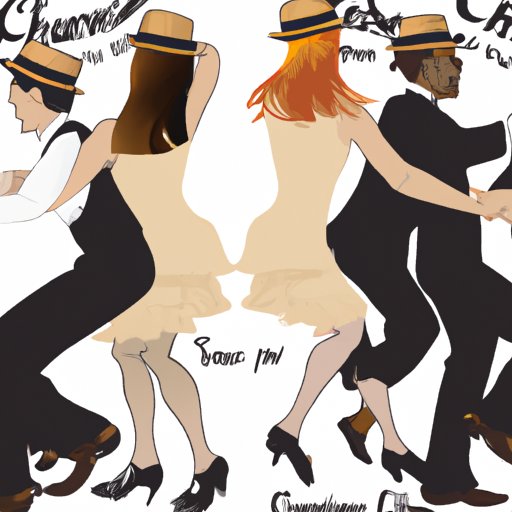Introduction
The Charleston is a fast-paced, lively dance that originated in the early 1920s. It was initially performed by African Americans in the Southern United States, but quickly gained popularity throughout the country and around the world. This fun, energetic dance is still popular today, and has been featured in many films and television shows over the years.

Definition of the Charleston Dance
The Charleston is an upbeat, energetic dance that is usually done solo or with a partner. It involves a lot of footwork and arm movements, as well as some light hopping and jumping. The dance is characterized by its quick, sharp movements, which create a sense of excitement and energy.

Overview of the History of the Charleston Dance
The Charleston dance first gained popularity in the 1920s, when it was adopted by white society. It was originally a solo dance, but soon evolved into a couple’s dance as well. The dance was featured in many early jazz songs, and became even more popular after it was featured in the Broadway show “Runnin’ Wild” in 1923. The song “The Charleston” was written for the show, and this further increased the popularity of the dance.
The Charleston was seen as a rebellious dance at the time, as it was considered risque and scandalous. It was often the subject of controversy, and was eventually banned in some cities. Despite the controversy, the Charleston remained popular throughout the 1920s and 1930s, and continues to be danced today.

How to Perform the Charleston Dance
Performing the Charleston is fairly easy, and most people can learn the basic steps fairly quickly. To begin, stand with your feet slightly apart and your arms outstretched in front of you. Start by taking two small steps forward, followed by two small steps backward. Then, take two quick side steps, followed by two quick side steps in the opposite direction. Repeat this pattern until you feel comfortable with the steps.
When performing the Charleston, it’s important to keep your body relaxed and your movements sharp and precise. You should also focus on keeping your head up and your arms outstretched, as this will help you stay on beat and maintain your balance. Finally, make sure to have fun while doing the Charleston. The more you enjoy yourself, the better you’ll perform!
Tips for Improving Your Technique
Once you’ve mastered the basic steps of the Charleston, there are several ways you can improve your technique. First, practice with a partner. When dancing with someone else, you’ll need to be aware of their movements and adjust your own accordingly. This will help you develop a better sense of timing and rhythm. Additionally, try to incorporate different variations of the steps into your routine. This will add variety to your performance and make it more interesting. Finally, practice frequently. The more you practice, the more comfortable and confident you’ll become with the steps.
Famous Performers of the Charleston Dance
Throughout the years, many famous performers have showcased their skills at the Charleston dance. One of the most famous is Anna Pavlova, a Russian ballerina who was renowned for her grace and athleticism. She often incorporated the Charleston into her performances, and was known for her skillful execution of the dance.
Another well-known performer of the Charleston is Fred Astaire, who often danced the dance with his partner Ginger Rogers. Together, they performed the dance in several classic films, such as Top Hat and Swing Time. Their performances showcased the grace and skill needed to perform the Charleston correctly.

Styles of the Charleston Dance
The Charleston can be performed in a variety of styles, depending on the number of people involved. The most common styles are solo Charleston, couples Charleston, and group Charleston. Solo Charleston is performed by one person, and is characterized by quick, sharp movements. Couples Charleston is performed by two people, and typically involves more complicated steps and patterns. Group Charleston is performed by three or more people, and involves intricate choreography and synchronized movement.
Benefits of the Charleston Dance
In addition to being a lot of fun, the Charleston also offers several physical and mental benefits. By performing the Charleston, you can improve your coordination and balance, increase your stamina, and become more flexible. Additionally, the Charleston is an excellent form of exercise, as it requires you to move your entire body. Finally, learning the Charleston can be a great way to socialize and meet new people, as it is often performed in groups.
Music for Doing the Charleston Dance
The best music for performing the Charleston is classic jazz, swing, and ragtime music. These genres feature upbeat tempos and lively rhythms, making them perfect for getting into the groove. Additionally, classic jazz songs often contain lyrics that reference the Charleston, making them even more suitable for the dance. Popular songs for doing the Charleston include “Ain’t Misbehavin'” by Fats Waller and “The Charleston” by James P. Johnson.
Conclusion
The Charleston is a fun and energetic dance that has been popular for more than a century. It has a rich history, and is still enjoyed by many people today. Learning the Charleston can be a great way to get fit, improve your coordination and balance, and meet new people. So why not give it a try? All you need is some good music and a few basic steps, and you’ll be on your way to mastering the Charleston.
(Note: Is this article not meeting your expectations? Do you have knowledge or insights to share? Unlock new opportunities and expand your reach by joining our authors team. Click Registration to join us and share your expertise with our readers.)
